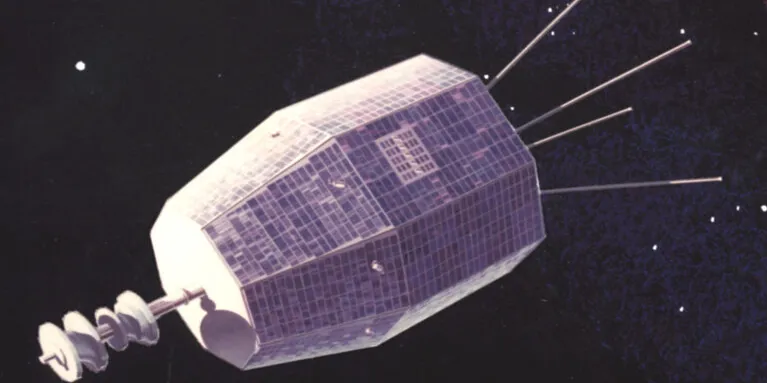
NASA satellite emits ‘spark’ decades after going dormant: Astronomers think they know why
How did your country report this? Share your view in the comments.
Diverging Reports Breakdown
NASA satellite emits ‘spark’ decades after going dormant: Astronomers think they know why
Astronomers tracked the source of the radio waves to a location that matches that of NASA’s defunct Relay 2 spacecraft. The spacecraft operated until June 1967 after both of its onboard transponders failed. The waves more likely came from a “spark” of built up electricity, which emitted a pulse as it jumped from one part of the spacecraft to another while passing through charged environment above Earth’s atmosphere. The discovery marks the first time that a spark of built-up electricity has been observed to be both so bright and so short in duration, the researchers say. The research has been accepted for publication in the Astrophysical Journal Letters. The researchers have also theorized that an impact with a tiny particle of space debris, known as a “micrometeoroid,” could have caused the anomaly. The finding could even help humanity better understand how electrostatic discharges can pose a danger to satellites in Earth’s orbit.
So, has the long-dead satellite has suddenly sprung back to life after nearly 6 decades? Astronomers say that’s unlikely.
The team of astronomers discovered the strange signal while hunting for bright, powerful flashes of electromagnetic radiation in the distant universe known as fast radio bursts.
While incredibly bright, the event only lasted less than 30 nanoseconds.
A NASA satellite that had been dead for nearly six decades issued a surprising sign of life.
In June 2024, a team of astronomers were perplexed when a radio telescope in Australia scanning the sky over the southern hemisphere came across unusual radio waves. The burst of radiation was very bright, exceedingly quick – and much closer to Earth than the scientists would have thought.
After studying the source of the strange cosmic phenomena, the researchers were even more mystified when it appeared to be originating from the same location as a NASA spacecraft that went offline about 58 years ago, according to a press release about the discovery released June 25, 2025.
Don’t be fooled, though: The defunct spacecraft that operated for about three years in the 1960s isn’t kicking back on to resume operations anytime soon.
So, what’s going on? Here’s what to know about the strange signal, and how astronomers tracked it to a defunct NASA satellite.
What is NASA Relay 2 spacecraft?
Astronomers tracked the source of the radio waves to a location that matches that of NASA’s defunct Relay 2 spacecraft, a communications satellite that launched into orbit in 1964 from Cape Canaveral, Florida.
The spacecraft operated until June 1967 after both of its onboard transponders failed.
So, has the long-dead satellite has suddenly sprung back to life after nearly six decades? Astronomers say that’s unlikely.
Rather, the waves more likely came from a “spark” of built up electricity, which emitted a pulse as it jumped from one part of the spacecraft to another while passing through charged environment above Earth’s atmosphere, according to the researchers.
Strange signal originated in Milky Way
The team of astronomers discovered the strange signal while hunting for bright, powerful flashes of electromagnetic radiation in the distant universe known as fast radio bursts.
Most surprising to the researchers, all of whom are from the International Centre for Radio Astronomy Research, was that the signal spotted June 13, 2024, didn’t originate from a far-flung galaxy. Instead, it originated in our own cosmic neighborhood in the Milky Way.
While incredibly bright, the event only lasted less than 30 nanoseconds. The astronomers detected it using Australia’s national science agency’s (CSIRO) ASKAP radio telescope.
Clancy James, an astrophysicist at Curtin University in Australia’s Perth campus, then led a team that studied the extremely bright source of radio waves to determine its source.
While the satellite signal is one possible explanation, the researchers have also theorized that an impact with a tiny particle of space debris, known as a “micrometeoroid,” could have caused the anomaly. Such impacts can create short-lived clouds of hot, charged gas that produce bursts of radio waves.
Electrostatic discharges could post threats in Earth’s orbit
The discovery marks the first time that a spark of built-up electricity has been observed to be both so bright and so short in duration.
Now that the detection has been made, the finding not only demonstrates how astronomers can help identify the origin of these kinds of signals in the future, but could even help humanity better understand how electrostatic discharges can pose a danger to satellites in Earth’s orbit.
“Detections like this show how the tools developed to study the distant Universe can help scientists understand the increasingly crowded and critically important space environment close to Earth,” the researcher said in a statement.
The research has been accepted for publication in Astrophysical Journal Letters. A pre-print version of the paper is available on arXiv.
Eric Lagatta is the Space Connect reporter for the USA TODAY Network. Reach him at elagatta@gannett.com
